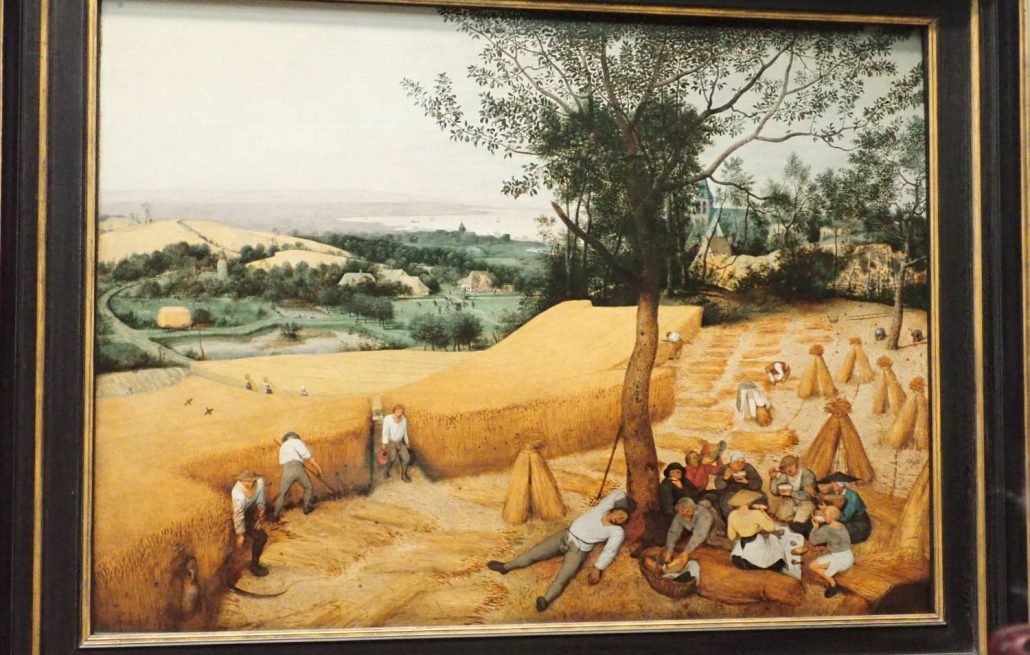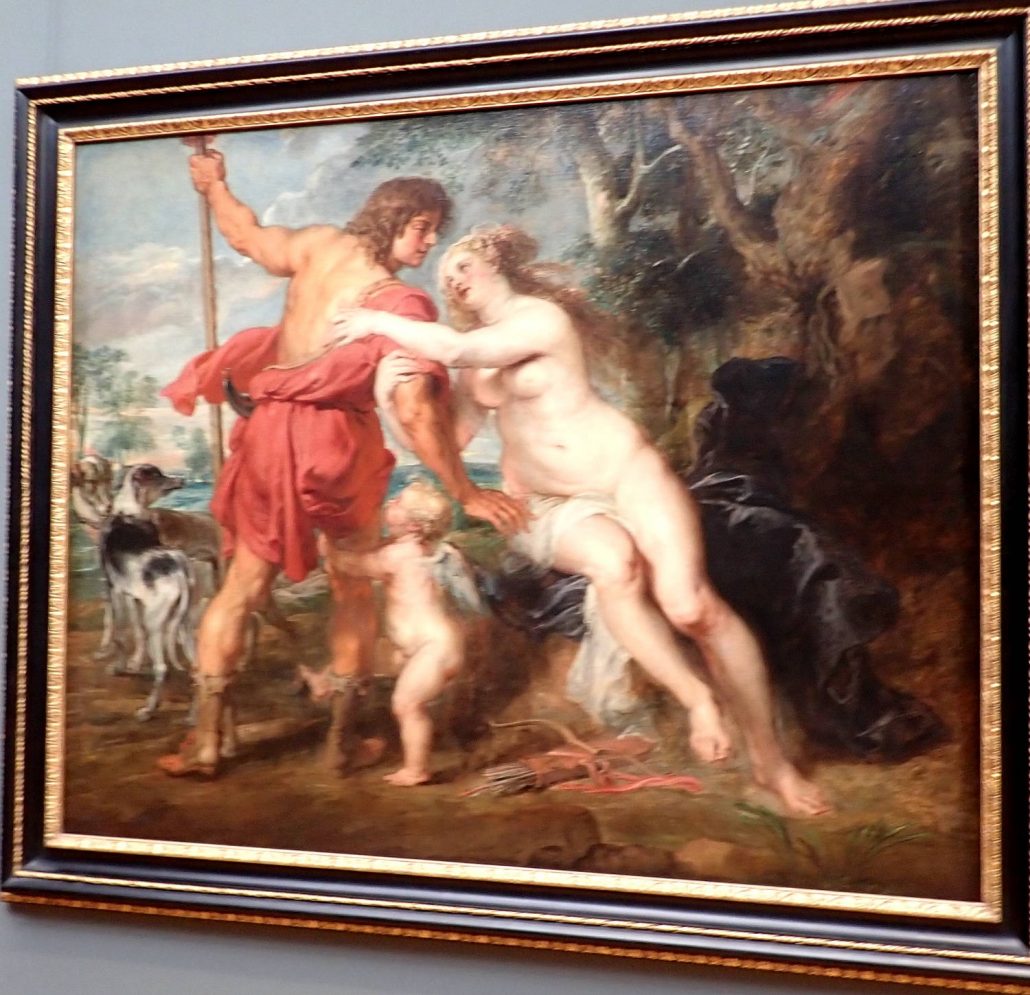On the Road is a weekday feature spotlighting reader photo submissions.
From the exotic to the familiar, whether you’re traveling or in your own backyard, we would love to see the world through your eyes.
Good Morning All,
On The Road and In Your Backyard is a weekday feature spotlighting reader submissions. From the exotic to the familiar, please share your part of the world, whether you’re traveling or just in your locality. Share some photos and a narrative, let us see through your pictures and words. We’re so lucky each and every day to see and appreciate the world around us!
Submissions from commenters are welcome at tools.balloon-juice.com
Have a wonderful day, and enjoy the pictures!
Today, pictures from valued JRinWV; we’ll continue this set soon.

This is among the most famous paintings anywhere. ” A watershed in the history of Western art and the first modern landscape. A sense of distance is conveyed with the workers carrying sheaves of wheat or resting in the foreground, and the hazy grey of the bay with ships far away.”
So our guide showed this as a transition between Egyptian decorative work, classical Greek and Roman art, and modern Impressionist Art.

Another very famous painting, by Deigo Valazquez, a portrait of Juan de Preja who was his assistant. Valazques was a Spanish painter, the leading artist in the court of King Philip IV and one of the most important painters of his time. He was an individualistic artist of the contemporary Baroque period. In addition to numerous renditions of scenes of historical and cultural significance, he painted scores of the Spanish royal family, other notable European figures, and commoners, culminating in the production of his masterpiece Las Meninas (1656).
Juan de Preja was a slave, inherited by Valazquez, and freed by him while they visited Rome. The manumission document is in an archive in Rome.
From the first quarter of the nineteenth century, Velázquez’s artwork was a model for realist and impressionist painters, in particular Edouard Manet. Since that time, famous modern artists, including Picasso and have paid tribute to Velázquez by recreating several of his most famous works.

By Peter Paul Reubens, Venus and Adonis, with a cute little cupid too. Another giant of his age, one of the most famous artists in Europe born in 1577 and died in 1640. Obviously I am looking all this up… The Impressionists studied these paintings as students, and then went their own way.

Claude Monet, Haystack with Snow and Sunshine, behind our guide, Maite of ArtSmart. I cannot say the name of the painting in front of her. Perhaps we will all learn from our combined experience, I have learned that someone here is bound to know a lot about about everything. Even Opera!

by Claude Monet, Bridge Over a Pond with Water Lilies another massively famous work.

Vincent van Gogh, Wheat Field with Cypresses — my last photo from the Impressionist visit to the Metropolitan Museum. Has anyone not seen work by van Gogh? And such a tragic story, massivly gifted but also tormented by mental illness.
Thank you so much JRinWV, do send us more when you can.
Travel safely everybody, and do share some stories in the comments, even if you’re joining the conversation late. Many folks confide that they go back and read old threads, one reason these are available on the Quick Links menu.
One again, to submit pictures: Use the Form or Send an Email

HeartlandLiberal
Which museum? I could not find it mentioned in descriptive text. Some museums have begun not allowing visitors to take pictures. The Van Gogh museum in Amsterdam has staff spotted everywhere, and visitors who attempt photos are quickly told no, put the camera, phone, selfystick away.
JPL
The colors of The Harvesters are incredible because of the age of the painting. .
@HeartlandLiberal: It’s at the bottom
Vincent van Gogh, Wheat Field with Cypresses — my last photo from the Impressionist visit to the Metropolitan Museum. Has anyone not seen work by van Gogh? And such a tragic story, massivly gifted but also tormented by mental illness.
David Evans
The Monet painting is of the cathedral at Rouen. He painted it more than 30 times in different lighting. There is even one in my home museum, the National Museum of Wales in Cardiff.
blueindixie
@HeartlandLiberal:
There can be many reasons a museum might have a no photography policy.
That the cumulative effect of camera flashes is not good for the work.
Also photos of the work could possibly be reproduced for sale while the works copyright owners rights are not respected.
kathyp
The paining is Claude Monet Rouen Cathedral The Portal at Midday
arrieve
@HeartlandLiberal: This is the Metropolitan Museum in New York. I know those paintings very well! It’s been years since I’ve been there though — I need to haul my ass uptown.
rikyrah
Beautiful art…sigh…
Virginia
A couple of weeks ago we went to Houston to see the Van Gogh exhibit at the Houston Museum of Fine Art. It was a fantastic showing of his work. Highly recommend it.
Steve in the ATL
@JPL:
I come from a family of artists. They are all crazy. Comes with the territory.
(I got the recessive gene in the family–I’m able to get up in the morning and go to work)
Betsy
@Steve in the ATL: The idea that artists are all nutty or that it comes with the territory is both false and hurtful to artistic people and artists. Please. Some artists have issues, and some don’t, just like other people.
Miss Bianca
Some of my favorites in there, J R!
mad citizen
If I recall correctly, the Art Institute of Chicago has a few/several of those Haystack paintings. I can’t blame museums for no-photo policy (like a Bob Dylan concert). I’ve always been surprised that museum paintings are open to the air between the painting and the viewer.
HinTN
Loving Vincent and a recent movie with actors about his life and friendship with Paul Gauguin are well worth your time.
J R in WV
Hey, folks, glad to see these photos finally see the light of B-J.
I took these last November when friends and I spent a week in Manhattan seeing sights and taking in the party. Two musical events, a Broadway show (Wicked – highly recommended, it speaks of today in the US!) great food, we visited the American Museum of Natural History one day and the Met the next. Also photos from the Empire State Building. You may recall seeing some pics of butterflies from that museum. There are big Sackler wings in both museums, the family that brought us oxy-based painrelief meds.
It was an expensive trip, but for Mike and Ruth, my friends in tourism, it was a bucket list trip, neither of them had been to NYC as adults and I greatly enjoyed showing them the town.
November is a huge month in Manhattan tourism, but a large percentage of that is shopping rather than more traditional tourism. We did not go shopping beyond the neighborhood shops for snacks and drinks.
Did a traditional high-end Italian place, piano doing Sinatra tunes, everyone in black tuxedos, did a high end Jaapanese place very near the hotel.
Our last full day we went to a place across the street from Bryant Park with two Michelin stars for a very long lunch. Toward the end of that meal we were the next to last table left and I got up and viewed carefully all the giant art on the walls. The manager came to me and we talked about that art, and she took me back to the kitchen and the chef’s table there to see the last painting.
The Chef and the Artist turned out to be from the same farming district in Alsace France, after he had already selected her art for his restaurant. Very friendly place, not snooty at all, and the food was fabulous. Then the next day we all flew home on the Tuesday before Thanksgiving, it went very smoothly with no hassles, although it was crowded.
Interestingly we met exactly no one from Iran, although there were many wonderful people from Persia in NYC. Hmmm…
HinTN
Now that’s funny
HinTN
@J R in WV:
Name, please
J R in WV
Also, I do not use flash much at all, and certainly never in a museum. Available darkness is where it’s at for me, and thankfully some modern cameras do very well at very low light photography.
Mart
@Steve in the ATL: My artist friend and her artist husband work their tail bones off all winter preparing prints for sale; and apply to shows/pay entrance fees. They then spend nine months driving coast to coast to art fairs to sell their work. At the fair they set up their tents and haul their work in carts to hang for display. They tear down at the end of the day (many shows go late into the night), and set up early the next morning. During the show they have to sell to all manner of people, and try to politely move youngsters with soda or ice cream cones away from their work. When the show ends they haul their asses across the country for the next fair. I never considered this to be a lazy persons job.
Also too, thanks J R in WV for sharing your trip to NYC.
J R in WV
@HinTN:
@J R in WV:
…place across the street from Bryant Park with two Michelin stars…
Name, please
Tenar Arha
FYI Most museums have really changed their photography policy bc of cellphones. But there’s usually 3 caveats.
1) the fragility of certain works/environments means that they don’t want anyone accidentally using flash
2) the demand of people trying to line up the perfect shot has endangered other artworks
3) Private Collections are often incredibly proprietary about their visual copyrights &/ they’re worried about their property being targeted when it leaves the museum’s hands. Bc although getting your painting seen in a blockbuster show is great for its value, it ups your exposure. (This goes under “collectors are weird about revealing what they own”).
#3 has been becoming more common as museums get priced out of the market & art disappears into private homes & vaults as investment.
sukabi
@Betsy: there’s a very good chance that a lot of the history of “artists are mentally ill” business stems from the artist not conforming to society’s standards of decorum, and community rejection / condemnation of the nonconformist.
HinTN
@sukabi: Yep